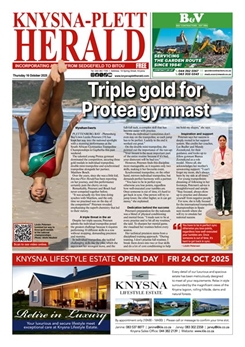While the R45-million cannot cover all the expenses that will be incurred by the extension, plans have been formulated to cover the additional expenses. Dr Earle du Plooy, Knysna Hospital superintendent, explained, "The building costs are covered by the grant we received from the Department of Health, but we will need to utilise our current capital equipment funding, as well as source external funding from health technology departments in order to fully equip the new building."
He added, "The new radiography department will receive a Picture Archive Computerised System (PACS), which essentially will allow us to take digital photographs. This is a leading mechanism in health care as the system gives us the capability to share the x-rays via various modes of technology, including e-mail. This will allow us to get opinions from specialists in a fraction of the time it would have, and this added input ultimately improves our knowledge and skills base."
Du Plooy said that the extension is imperative to allow the hospital to increase its functionality and healthcare quality. "We want to provide all the necessary services under one roof so that people will not need to travel to the larger hospitals ie George Provincial Hospital, for assistance. We face many challenges, but I believe that our objectives are attainable," Du Plooy concluded.
It is expected that the project will commence in July and take 18 months to complete.
The Knysna Provincial Hospital Board is also delighted by the prospects of an extended and better equipped hospital. Board chairperson, Richard Dawson said that the extension of the facilities will make a great difference in the lives of Knysna's people.
Apart from the obvious benefits to patients at the hospital, the local economy will also get a boost as a result of the project. It has been stipulated that the developers must use as many local contractors as possible to fulfil the various functions during the development process.
Dawson said that the Knysna Hospital Board was very pleased and appreciative of the approval of the R45-million grant. He described the envisaged extension as the "cherry on the top" of several donations from a loyal and supportive community. He said that besides kind people's thoughtful donations of toys, blankets, curtains, toiletries or time spent visiting patients, the Knysna Hospital has also been the beneficiary of several service clubs and churches during recent years.
These donations include upgrading of the hospital's step-down respite facility, which received new beds and a garden. The interior of the building is currently being painted and the exterior walls and roof will be painted as part of the extension project.
Also in recent years, the Fancourt Foundation, via the hospital board, donated the ARV clinic building, an effective and well-run facility of which Knysna has reason to be proud. The walls are covered in local children's art, while a jungle gym (donated by another organisation) entertains youngsters who accompany their parents to the clinic.
The Rotary Club of Knysna sponsors specialist ear, nose and throat procedures for one week each year. In an effort to assist ENT doctors in their task, Rotary has also donated specialised equipment to the hospital. Other Rotary gifts include new beds and sonar equipment. The Rotary Annes have introduced the Kangaroo Project to help premature babies to thrive, while their Help the Babies project ensures that all newborn babies at the hospital has clothing. Many kind Knysna residents also knit for the children, make blankets and donate toys.
The Lions Club of Knysna sponsors much of the eye-care work performed at the hospital. At least twice a year, the club organises a series of cataract operations, resulting in at least 120 people having their sight restored every year. In total more than 2 000 people in the area have benefited from this initiative.
Dawson said that the extension of the hospital's treatment facilities, which builds upon the people of Knysna's support, will make a measurable difference in the lives of many.
.jpg)
A three-dimensional image of the extended Knysna Provincial Hospital.
















